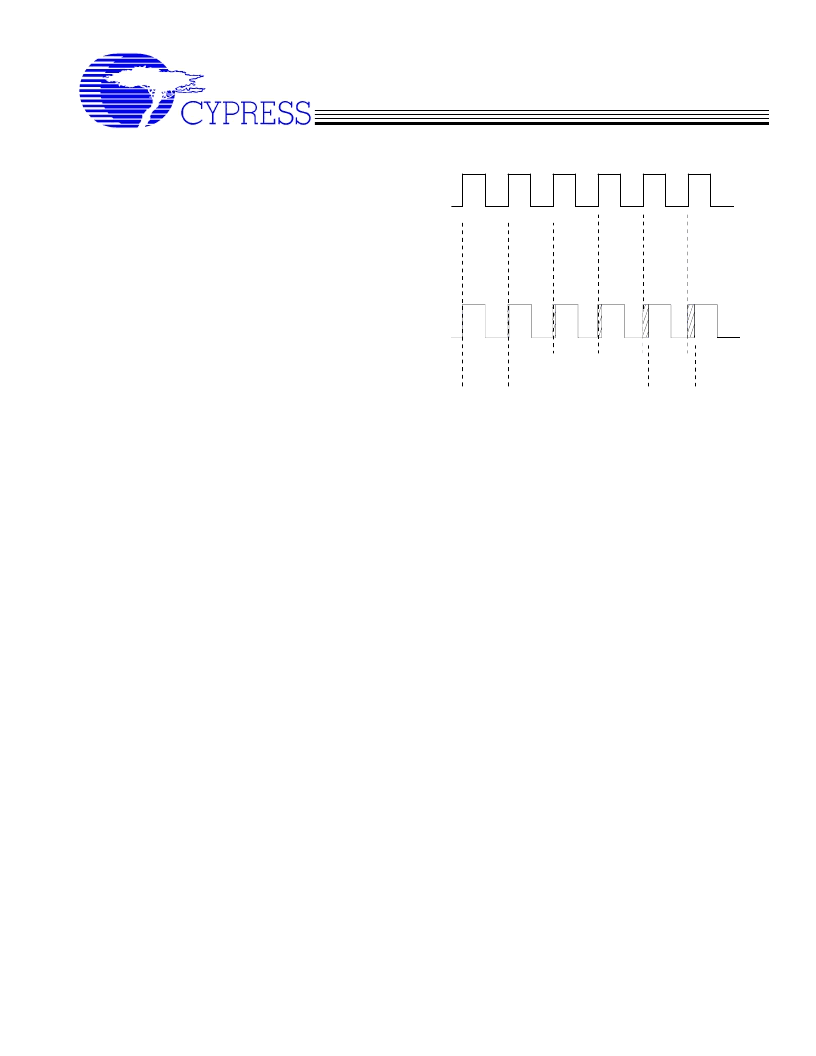- 您現(xiàn)在的位置:買賣IC網(wǎng) > PDF目錄370241 > FS786BZ MISCELLANEOUS CLOCK GENERATOR|SOP|8PIN|PLASTIC PDF資料下載
參數(shù)資料
| 型號: | FS786BZ |
| 英文描述: | MISCELLANEOUS CLOCK GENERATOR|SOP|8PIN|PLASTIC |
| 中文描述: | 雜項時鐘發(fā)生器|??苵 8引腳|塑料 |
| 文件頁數(shù): | 10/13頁 |
| 文件大小: | 94K |
| 代理商: | FS786BZ |

Low EMI Spread Spectrum Clock
Cypress Semiconductor Corporation
525 Los Coches St.
Milpitas, CA 95035. Tel: 408-263-6300, Fax: 408-263-6571
http://www.cypress
Document#: 38-07031 Rev. **
05/04/2001
Page 10 of 13
APPROVED
PRODUCT
FS786/787
Tc = 50.50
Tc =49.50 ns.
We see that the original 20 MHz reference clock is at the center
Frequency, Cf, and the minimum and maximum extremes are
positioned symmetrically about the center frequency. This
type of modulation is called
Center-Spread
. Figure 8 shows a
20 MHz clock, as it would be seen on an oscilloscope. The top
trace is the non-modulated reference clock,. The bottom trace
is the modulated clock at pin 6. From this comparison chart you
can see that the frequency is decreasing and the period of each
successive clock is increasing. The Tc measurements on the
left and right of the bottom trace indicate the max. and min.
extremes of the clock. Intermediate clock changes are small
and accumulate to achieve the total period deviation. The
reverse of this figure would show the clock going from min.
extreme back to the high extreme.
Figure 8. Period Comparison Chart
Looking at figure 7, you will note that the peak amplitude of the 20 MHz non-modulated clock is higher than the
wideband modulated clock. This difference in peak amplitudes between modulated and unmodulated clocks is the
reason why SSCG clocks are so effective in digital systems. This figure refers to the fundamental frequency of a
clock. A very important characteristic of the SSCG clock is that the bandwidth of the fundamental frequency is
multiplied by the harmonic number. In other words, if the bandwidth of a 20 MHz clock is 200 kHz, the bandwidth
of the 3
rd
harmonic will be 3 times 200, or 600 kHz. The amount of bandwidth is relative to the amount of energy
in the clock. Consequently, the wider the bandwidth, the greater the energy reduction of the clock.
Most applications will not have a problem meeting agency specifications at the fundamental frequency. It is the
higher harmonics that usually cause the most problems. With an SSCG clock, the bandwidth and peak energy
reduction increases with the harmonic number. Consider that the 11
th
harmonic of a 20 MHz clock is 220 MHz.
With a total spread of 200 kHz at 20 MHz, the spread at the 11
th
harmonic would be 2.20 MHz which greatly
reduces the peak energy content. It is typical to see as much as 12 to 18 dB. reduction at the higher harmonics,
due to a modulated clock.
The difference in the peak energy of the modulated clock and the non-modulated clock in typical applications will
see a 2 - 3 dB. reduction at the fundamental and as much as 8 - 10 dB. reduction at the intermediate harmonics,
3
rd
, 5
th
, 7
th
etc. At the higher harmonics, it is quite possible to reduce the peak harmonic energy, compared to the
unmodulated clock, by as much as 12 to 18 dB.
相關(guān)PDF資料 |
PDF描述 |
|---|---|
| FS787BZ | MISCELLANEOUS CLOCK GENERATOR|SOP|8PIN|PLASTIC |
| FS7KM12 | TRANSISTOR | MOSFET | N-CHANNEL | 600V V(BR)DSS | 7A I(D) | SOT-186 |
| FS7KM-12A | TRANSISTOR | MOSFET | N-CHANNEL | 600V V(BR)DSS | 7A I(D) | TO-220FN |
| FS7KM14A | TRANSISTOR | MOSFET | N-CHANNEL | 700V V(BR)DSS | 7A I(D) | SOT-186 |
| FS7KM16A | TRANSISTOR | MOSFET | N-CHANNEL | 800V V(BR)DSS | 7A I(D) | SOT-186 |
相關(guān)代理商/技術(shù)參數(shù) |
參數(shù)描述 |
|---|---|
| FS786BZB | 制造商:IMI 功能描述: |
| FS787BZ | 制造商:未知廠家 制造商全稱:未知廠家 功能描述:MISCELLANEOUS CLOCK GENERATOR|SOP|8PIN|PLASTIC |
| FS78-8-5K2 | 功能描述:端子 Insulated Ferrules on Reels, single wire RoHS:否 制造商:AVX 產(chǎn)品:Junction Box - Wire to Wire 系列:9826 線規(guī):26-18 接線柱/接頭大小: 絕緣: 顏色:Red 型式:Female 觸點電鍍:Tin over Nickel 觸點材料:Beryllium Copper, Phosphor Bronze 端接類型:Crimp |
| FS78-8-DSL2 | 功能描述:端子 16 AWG RED SOLD PER 50 PC STRIP RoHS:否 制造商:AVX 產(chǎn)品:Junction Box - Wire to Wire 系列:9826 線規(guī):26-18 接線柱/接頭大小: 絕緣: 顏色:Red 型式:Female 觸點電鍍:Tin over Nickel 觸點材料:Beryllium Copper, Phosphor Bronze 端接類型:Crimp |
| FS791 | 制造商:CYPRESS 制造商全稱:Cypress Semiconductor 功能描述:Low EMI Spectrum Spread Clock |
發(fā)布緊急采購,3分鐘左右您將得到回復(fù)。